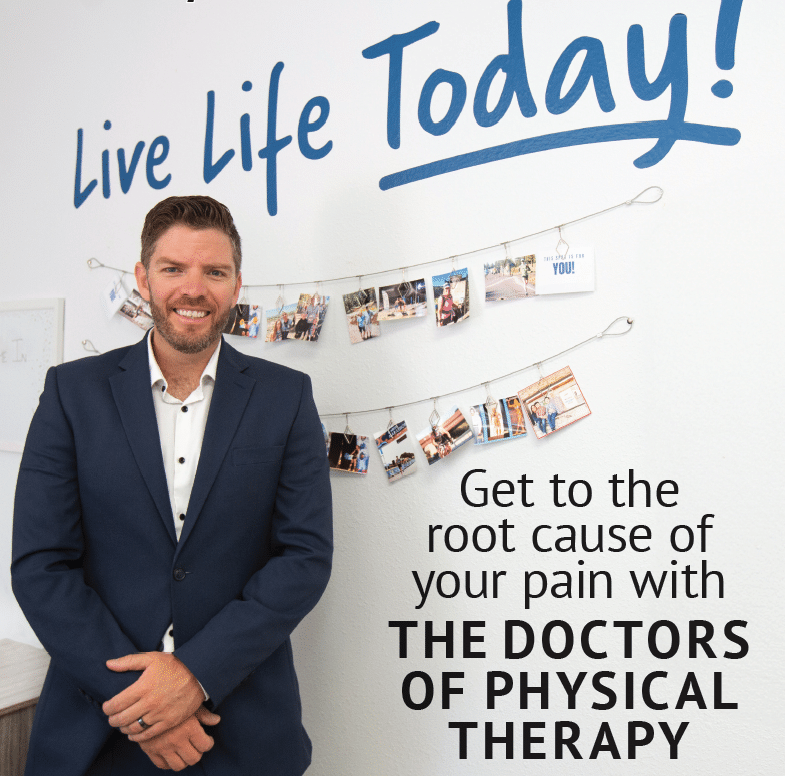Photo by Kimberly Carrillo
Just three months out of physical therapy school with swelling elbows, hands, knees, and feet, and unable to open jars or use stairs, Dr. Tom Padilla, 25, went to see a physician through his insurance plan. But after reviewing the X-rays, the doctor told him that he “had arthritis and would have to learn to live with it.” He was stunned, as the doctor would not run further tests, and simply offered him anti-inflammatory medication.
Nine months after the diagnosis, seeing other health plan doctors for a second opinion, numerous tests, and trying several unconventional remedies, it turned out to be mold toxicity. Dr. Padilla recovered — and learned a lesson that he applies to his medical practice The Doctors of Physical Therapy (DPT) in Scottsdale.
“Over the past five years of growing this clinic, I’ve made sure situations like mine are not what our clients experience,” Dr. Padilla says. “A lot of our clients come in with the same struggles I had when trying to find a cure for my ailments.”
Those struggles include:
• Doctors who don’t have time for or have no interest in treating the whole person.
• Healthcare providers who don’t know what to do when a patient doesn’t fit into a known diagnosis in the medical system.
• No communication between doctors.
• Doctors who prescribe pills to manage symptoms rather than find the root cause.
“This is why I stress to all of our staff and clients that we’re different for a reason,” Dr. Padilla says. “We are continuously working to improve the experience our patients have, and we go to great lengths to make sure our outcomes are as good as possible.”
At DPT, Dr. Padilla guarantees:
1. Each of our clients will feel heard.
2. We collaborate between ourselves and other providers in difficult cases.
3. We establish goals that are important to our clients and their lives, not just goals limited to being able to do the day to day.
4. We work to find the root cause and change directions if something’s not working as quickly as we want it to.
During all his health problems, Dr. Padilla was also working in a big box physical therapy clinic he calls a “mill” with high patient volume and very little individualized care. These combined experiences, along with his medical experience, brought Dr. Padilla to Arizona to start a practice focused on the patient, how they deserve to be treated, and the outcomes that are important to them.
“I’m proud to say that overall things are going to plan,” says Dr. Padilla. “DPT has helped more than 1,800 people in seven years to overcome injuries they once thought they’d have to live with forever.”
One point of pride is the results DPT gets for people struggling with back pain or sciatica. “This is a condition that is largely considered ‘chronic and unchangeable’ by the medical community,” explains Dr. Padilla. “For years, opiates have been one of the primary ways to help someone with chronic back pain. Oftentimes the side-effects are worse than the pain! Over the past several years, our clinic has focused on solving the root cause of this problem and we’ve helped people that have had back pain for a few months to more than 20 years to resolve their symptoms and get back to the activities they enjoy without it coming back.”
DPT has stuck to its promises. Every plan of care is individualized to the patient. There’s no cookie-cutter approach, no one gets passed to an assistant to do exercises in a corner, and DPT makes sure that there is measurable and meaningful progress every few sessions–– otherwise, they change directions.
“We don’t want people feeling stuck or like they don’t know what’s wrong or why,” says Dr. Padilla. “At DPT, we want them to know why they’re doing the things we ask them, and what they can expect to see change and when. That way, if we don’t see those things changing, we can go another direction rather than continuing down the same path expecting different results.”
Dr. Padilla says one DPT patient flew down from Minnesota for care because he was 32 years old, already had two back surgeries, and didn’t want a fusion after being told he had another herniated disc. The patient was due to be a father and couldn’t bend forward to brush his teeth, let alone pick up a baby out of a crib. “Today, Grant is playing basketball, running, and having a blast with his 3-month-old son,” says Dr. Padilla.
Initially, Dr. Padilla’s desire to become a physical therapist was fueled during his years as a personal trainer, when clients would come to him saying they had been unable to overcome injuries despite years of efforts and many different doctors.
He received his doctorate in physical therapy in 2014 from the University of Southern California. “Although our football team has wavered from time to time, our top-ranking PT school has maintained a leading position over many years!” he says.
You can find Dr. Tom Padilla on social media
@DrTomPadilla, or YouTube
@thedoctorsofphysicaltherapy, where Dr. Padilla shares exercise tips and interviews with local doctors.
“I’m not your typical doctor, and DPT is not the typical physical therapy practice,” Dr. Padilla says. “I’ve been in patients’ shoes, and at DPT we’re on a mission to create a clear path to get people from injured back to a high-quality life where they can be active without needing to take pills or resort to surgeries.”
To obtain a copy of Dr. Padilla’s privately published guide, “Fixing The Root Cause: Beneath The Symptoms of Your Chronic Pain,” you can email [email protected] with the subject line “Fixing the Root Cause” with your name, phone number, and address.
To learn more about The Doctors of Physical Therapy, which is located at 8350 E. Evans Road, Suite C-2, in Scottsdale, visit thedoctorsofpt.com. Website visitors can also get free information on the blog or podcast. Call 480-482-0651 to schedule a complimentary “discovery visit.”
This content is sponsored by The Doctors of Physical Therapy.





